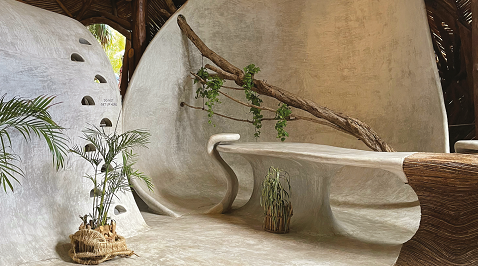Listen to the audio version of this article. Duration: 5 minutes.
The growing trend of biophilic design
The goal of biophilic design is to enhance people’s psycho-physical well-being by integrating natural elements into indoor environments. In recent years, this approach, rooted in the innate human tendency to thrive in nature, has also gained traction in product design, becoming one of the most prominent trends of 2024.

Biophilic design is one of the most current trends in design. It is inspired by biophilia, a term first coined in the 1970s by psychoanalyst Erich Fromm to describe the psychological tendency to be drawn to everything that is alive and vital, highlighting the ancestral, regenerative connection with nature and its elements. The concept was later popularised by biologist Edward Wilson in his book Biophilia (1984). Numerous scientific studies confirm the positive effects of outdoor life in natural environments on human health.
The focus of biophilic design is on enhancing the (re) connection between people and the natural environment. The adaptation of biophilia as a design approach for indoor spaces is credited to Stephen R. Kellert, Professor Emeritus at Yale University’s School of Forestry and Environmental Studies. He defined biophilic design through a framework of six elements and more than seventy attributes, which include the use of natural materials, green facades, sunlight, and botanical motifs. In essence, biophilic design aims to create environments that align with humanity’s innate affinity for natural systems and processes. This human-centred approach to interior and building design offers numerous benefits, including enhanced physical health, mood, and overall well-being. Additionally, biophilia contributes to improved productivity, reduced stress, increased concentration and creativity, better mental health, reduced fatigue, and the creation of positive spaces in harmony with nature. This leads to the idea that the built environment, often disconnected from nature, should be reimagined to align with this natural affinity. Biophilic design has emerged as an architectural and urban approach aimed at reintegrating natural elements into modern spaces, with the aim of enhancing the quality of life for those who inhabit them.
Transversal approach
Over recent decades, this design philosophy has gained incredible momentum, as awareness of sustainability and mental health has increased. It is now widely applied across various sectors and contexts, including workplaces, hospitals and healthcare facilities, schools and universities, as well as the hospitality and tourism industries.
Product design, too, has been influenced, with biophilic design rapidly becoming one of the most prominent trends of 2024. This trend has made its mark across a wide range of sectors, from interior and outdoor spaces to consumer electronics and lighting. Driven by the desire for people to reconnect with the natural world and live in harmony with it, this design approach incorporates elements, textures, and patterns made from sustainable materials. Examples include furniture and upholstered pieces with organic shapes and natural colours, consumer electronics featuring wood or stone finishes, and the integration of plants, water features, or natural lighting into the design.
Principles of biophilic design
1.Direct contact with nature:
This includes the integration of plants, water, natural light, and fresh air into interior spaces.
2.Indirect contact with nature:
The use of natural materials, colours inspired by the natural environment, organic forms.
3.Open and fluid spaces:
Environments that encourage visual connections with the outdoors and create a sense of spaciousness, promoting psychological well-being.
4.Dynamic elements:
The inclusion of variations in light, air, and sound that mimic natural conditions, such as the movement of leaves or the sound of running water.
5.Integration with surrounding nature:
Emphasising the environmental and landscape context, making buildings an integral part of the local ecosystem.
Copyright © Homa 2025
All rights reserved

.jpg?VGhlIFBlcmZlY3QgU2xvdC1pbijmraPnoa4pLmpwZw==)

































